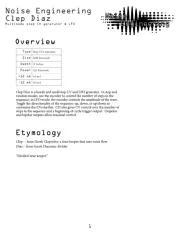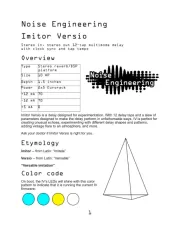Noise Engineering Quantus Pax Handleiding
Noise Engineering
Niet gecategoriseerd
Quantus Pax
Bekijk gratis de handleiding van Noise Engineering Quantus Pax (4 pagina’s), behorend tot de categorie Niet gecategoriseerd. Deze gids werd als nuttig beoordeeld door 12 mensen en kreeg gemiddeld 3.8 sterren uit 6.5 reviews. Heb je een vraag over Noise Engineering Quantus Pax of wil je andere gebruikers van dit product iets vragen? Stel een vraag
Pagina 1/4

Overview
Quantus Pax is a four-channel precision adder, buffered multiple, and polyphonic transposition utility. Each
channel has two CV inputs and can be further modified by the three Xpose inputs. QP is made with high
quality low-tolerance resistors for unbeatable accuracy. Patch-wide key changes, polyphonic movement,
mathematically derived melodies, and more are all to be had with this simple but useful utility.
1
Noise Engineering
Quantus Pax
4-channel transposable precision adder
Type
Quantus Pax
Size
6HP Eurorack
Depth
.8 Inches
Power
2x5 Eurorack
+12 mA
85 mA
-12 mA
85 mA
Etymology
“How much harmony”
Pax -- from Latin: “harmonious”
Quantus -- from Latin: “how many”

Power
Screw your module into your case BEFORE powering on the
module. You risk bumping the module’s PCB against something
metallic and damaging it if it’s not properly secured when powered
on.
To power your Noise Engineering module, turn off your case. Plug
one end of your ribbon cable into your power board so that the red
stripe on the ribbon cable is aligned to the side that says -12v and
each pin on the power header is plugged into the connector on the
ribbon. Make sure no pins are overhanging the connector.
Line up the red stripe on the ribbon cable so that it matches the
white stripe and/or -12v indication on the board and plug in the
connector.
You should be good to go if you followed these instructions. Now
go make some noise!
A final note. Some modules have other headers -- they may have a
different number of pins or may say NOT POWER. In general,
unless a manual tells you otherwise, DO NOT CONNECT THOSE
TO POWER.
Warranty
Noise Engineering backs all our products with a product warranty: we guarantee our products to be free
from manufacturing defects (materials or workmanship) for one year from the date of the original retail
purchase (receipt or invoice required). The cost of shipping to Noise Engineering is paid by the user.
Modules requiring warranty repair will either be repaired or replaced at Noise Engineering's discretion. If
you believe you have a product that has a defect that is out of warranty, please contact us.
This warranty does not cover damage due to improper handling, storage, use, or abuse, modifications, or
improper power or other voltage application.
2

Interface
Lower input 1-4:
Output 1-4:
CV input. Summed with channel’s lower input and the three xpose
inputs. The upper inputs of each channel are circularly normalled
together; patching to an input breaks normalization.
CV outputs. Sum of each channel’s two inputs and the three xpose
inputs.
CV inputs for global transposition. Each input is summed to all four
channels simultaneously.
Upper input 1-4:
Xpose inputs:
CV input. Summed with channel’s upper input and the three xpose
inputs.
3
4
Quantus Pax
1
2
3
xpose
Patch Tutorial
Patch 1:
Patch a sequence to the upper input of channel 1. Patch another sequence
or other 1v/octave voltage source to channel 1’s lower input. Patch
channel 1’s output to an oscillator’s pitch input. Listen to how the two
sequences sum together and create new-but-related melodies.
Since the upper inputs of each channel are normalled together, QP can be
used as a buffered multiple with a twist. Using the same patch as the
previous example, patch some of the other channel’s outputs to other
pitch destinations in your system. The signal is split pitch-accurately to
each output.
Take two pitch CV sources. Mult them to two oscillators and to the first
and second inputs of a channel of QP. Take the QP channel’s output and
patch it to a third oscillator. A new melody has been created, based off of
the pitch information of the other two notes.
Summing melodies and harmonies to create new countermelodies is a
great way to generatively create mathematically related musical ideas.
Patch 3:
For even more fun, the original sequence can then be modified per-
channel by inputting other voltages to each channel’s lower input.
Patch 2:
Patch 4:
Patch each CV of a polyphonic pitch sequence (like a chord or multiple
melodies/harmonies) to separate channels on QP. The xpose inputs can
now be used to transpose all four inputs at once. A separate sequence or
octave switch like Quant Gemi can be used for transposition, an LFO
can be used to add universal vibrato, and more.
Product specificaties
| Merk: | Noise Engineering |
| Categorie: | Niet gecategoriseerd |
| Model: | Quantus Pax |
Heb je hulp nodig?
Als je hulp nodig hebt met Noise Engineering Quantus Pax stel dan hieronder een vraag en andere gebruikers zullen je antwoorden
Handleiding Niet gecategoriseerd Noise Engineering

18 Maart 2025

18 Maart 2025

18 Maart 2025

18 Maart 2025

18 Maart 2025

18 Maart 2025

18 Maart 2025

18 Maart 2025

6 December 2023

25 Juli 2023
Handleiding Niet gecategoriseerd
- Slik
- ClearOne
- Vivitar
- Stabila
- Naim
- Mercyu
- Cleveland
- Heatfab
- Crunch
- FeinTech
- Masport
- Toolland
- ENS
- Doomoo
- Magnus
Nieuwste handleidingen voor Niet gecategoriseerd

14 September 2025

14 September 2025

13 September 2025

13 September 2025

13 September 2025

13 September 2025

13 September 2025

13 September 2025

13 September 2025

13 September 2025